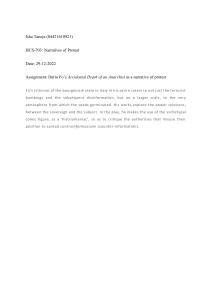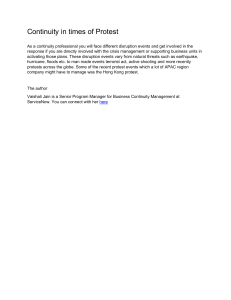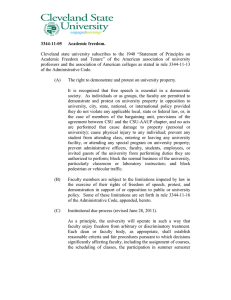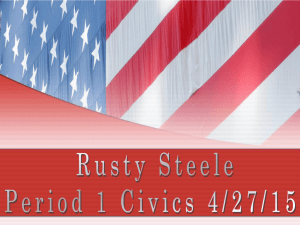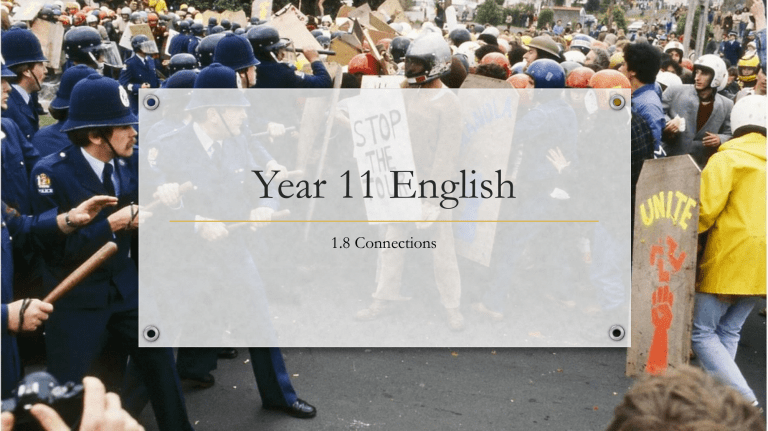
Year 11 English 1.8 Connections Protest • This term, we are focusing on the theme and language of protest • We will explore the different ways that people protest or push back against unjust systems of power in society. Protest or Not? 1. Changing social media profile picture to Ukraine flag. 2. Donating money to an environmental group or cause. 3. Tweeting about a social issue and using a trending hash tag. 4. Attending a physical protest. 5. Boycotting a brand. 6. Writing a blog post about a social issue. 7. Volunteering to hand out pamphlets for a cause. 8. Striking for pay. 9. Wearing an armband for LGBTQ support. 10. Throwing soup at a famous painting to bring attention to climate change. Let’s put the examples above on a continuum of active or passive, effective, non-effective. Your answers will depend on what you think the purpose of protest really is. The worksheet can be found on the OLE. Question: What kind of thinking do people often resist, or push back against? Question: How do you think technology and social media have changed the way people protest? Research Project Pick one of the three protests that you used in your presentation yesterday. Answer the following questions in a new word document: • Time period (when did the movement begin and when did it end) • Where did it happen? Was it a global or national movement? • What kind of world view or social norm were people protesting against? • What was the outcome of the protest movement? What changed or did not change? • Is there a symbol or famous image that exemplifies the protest or movement that you picked? What is it, and what does it say about your protest or movement? (make sure you add an image of this to your document) Babak Anvari- Two & Two (2011) Context • Babak Anvari, the director of“Two and Two” stated that “I believe that Two and two has a universal message which is not bound to any specific region or country. We still witness various forms of domineering powers in today’s world, in both the East and the West, which hold people back from making progress on pressing issues.” • What do you think a ‘totalitarian’ government is? Why is protest such a threat to this kind of government? • How do you think totalitarian governments keep their followers in line? Why would anyone support such a government? • What examples of real life censorship can you think of? Provide a brief description of your example. • This film draws in ideas from George Orwell’s novel 1984. Find and read a short summary of the novel. Identify the themes associated with the following pieces of dialogue: “Don’t think. You don’t need to think.” “How dare you question me?” Consider the language used by the teacher- how would you describe it and how does it relate to him keeping his power? Unpacking the Film What kind of costume decisions did the director make? How did they help you understand the message in the film? Why do you think a classroom was a particularly effective setting for the messages of the film? There are three main characters in the film: Teacher, Boy Who Is Shot, Boy At The End. What do you think the purpose of each character is in the film? What ideas or concepts about protest in the real world might these characters symbolise? Wider Links • What does this short film suggest about the dangers and complications of protesting and standing up for you beliefs in the real world? • Find examples of protests that have led to death or executions. Would you join a protest in these circumstances? Explain your reasoning. • What kind of consequences have there been for people protesting in New Zealand? Why do you think it’s important for people to have the right to protest even if you don’t agree with their ideas? Vocabulary: - Control Totalitarianism Censorship Related Texts: George Orwell “1984” (novel) James McTeigue “V for Vendetta” (film) Kurt Vonnegut “Harrison Bergeron” (short story) Amanda Gorman- The Hill We Climb (2021) Context • Let’s watch the videos about slavery and segregation on the OLE to better understand these terms. • Some people think that racism was 'solved' when slavery and segregation were abolished. However, African Americans have continued to deal with the aftermath. What do you think institutionalized racism is? • George Floyd's murder led to protests in America and around the world. What were people protesting against? • What had happened in Washington one week before President Biden's inauguration? • Why do you think some people thought that 'Black Lives Matter' excluded others? Why do you agree/disagree? Unpacking the Poem • What do you think the main themes in the poem are? What ideas does Gorman want the reader to focus on? • What is generational trauma and why might it be relevant to this poem? • What do you think the 'hill' in the poem refers to? What do 'light and darkness' symbolise in the poem? • Gorman uses 'we' throughout the poem. Who does the 'we' refer to? What effect did Gorman want her use of 'we' to have on the audience? • How could this poem, and Gorman’s performance, be seen as form of protest? Wider Links • What other instances of people contesting election results can you think of? Why do you think people need to come together as a group to protest things they wish would change? • Why do you think supporters protest at places of importance to the government or general public? What are they trying to achieve and what does this suggest about ‘successful’ protests? Try to think of an example from New Zealand. • How can you link the themes discussed in Gorman’s poem to New Zealand? Vocabulary: Othering Identity Related Texts: Maya Angelou “Still I Rise” Langston Hughes “I Look at the World” Propaganda, “20 Years” Your Own Experiences • In pairs, discuss anything you've done to spread awareness or take direct action for a cause. What Would You Do? • Hand in phones to school reception at the start of day. • Your employer does not pay you enough to live off. • You can't be in a relationship with the person you love because your sexuality is banned. • You can't publish an article because it disagrees with the government. • The government enforces conscription, so you have to complete military service. Emmeline Pankhurst, “Freedom or Death” (1913) Context • Who were the suffragettes and what was their main goal? • What kind of action did the suffragettes take to create change? • Why do you think people of the time thought that the suffragette’s demands were unreasonable? Who would have been threatened by women having more power? • What kind of effect did the suffragettes have on society? What did their protests manage to change? • How do you think racism and sexism overlapped in the suffragette movement? Were they championing ALL women or only some? Unpacking the Speech • Which extended metaphor does Pankhurst use in her speech? Why do you think she uses this? Support your answer with evidence. • What does Pankhurst think of violent action? • According to Pankhurst, what happened to women who were excluded from public meetings for asking questions? • Why does Pankhurst use the crying baby analogy? • What choice does the British government have to make? Wider Links • • How much do you think life has changed for most women since the suffragette movement? Do you think we have achieved equality? What recent law change in the US resulted in a lot of women protesting for bodily autonomy? What does the law change suggest about the way women are viewed? Vocabulary: Status Quo Revolution Related Texts: Margaret Atwood, “The Handmaid’s Tale” Maya Angelou, “Phenomenal Woman” Carol Ann Duffy, “Mrs Midas” Patricia Grace, “A Way of Talking” (1975) • The full text of the short story can be found on the OLE. Context • Use the following link to learn about the Māori Renaissance: https://teara.govt.nz/en/maori-pakeha-relations/page-6 • When did this Renaissance happen? What was it in response to? • Why do you think different marginalized cultures from around the world have periods of ‘renaissance’ or rebirth? Can you think of any global examples? • What is your understanding of the term ‘micro-aggression’? Should people try to the counter these instances of discrimination or not? Explain your reasoning. Unpacking the Short Story • What is the effect of including Māori words and names in the text of the short story? Why do you think Patricia Grace chose not to include a glossary? • Why do you think Rohe used “Pakehafied” language to confront Jane? Do you think Jane would have taken her seriously if she used her home-language? • Why was Hera embarrassed by Rohe telling Jan off ? • How do you think a mass move to the city affected traditional Māori life? • Hera and Rohe deal with an instance of everyday or casual racism. Why do you think people often let comments like these slide? Wider Links • How much more accepted is Te Reo Māori in New Zealand today? Consider the article about the use of Te Reo on the news. Connections How might the texts we have studied function as a form of protest? What have the texts taught you about who protests, why they protest, what they protest, whether their protests create change? Important Vocabulary • These concepts will come in handy when discussing protest. Which words are you already familiar with? In groups, write definitions for the words I assign you: Ideology Oppression Active or Passive Protest Censorship Revolution Totalitarianism Power Dystopia Control Identity Status Quo Othering Extension • • Look up the following terms: Generational Trauma Cultural Hegemony Intersectionality How do you think these terms relate to some of the texts we have watched and read? How do they relate to the idea of protest? • Discuss whether being yourself/staying true to your identity in public can be an act of protest.
